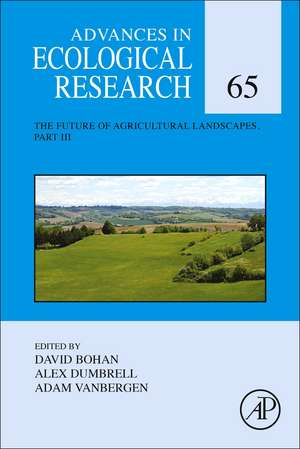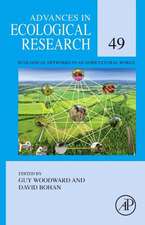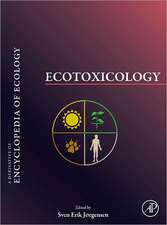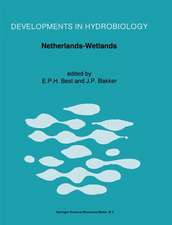The Future of Agricultural Landscapes, Part III: Advances in Ecological Research, cartea 65
Editat de David Bohan, Alex Dumbrellen Limba Engleză Hardback – 24 noi 2021
- Provides the authority and expertise of leading contributors from an international board of authors
- Presents the latest release in the Advances in Ecological Research series
- Updated release includes the latest information on the Future of Agricultural Landscapes
Din seria Advances in Ecological Research
-
 Preț: 746.77 lei
Preț: 746.77 lei - 27%
 Preț: 766.76 lei
Preț: 766.76 lei - 27%
 Preț: 758.08 lei
Preț: 758.08 lei - 27%
 Preț: 766.14 lei
Preț: 766.14 lei - 27%
 Preț: 759.42 lei
Preț: 759.42 lei - 27%
 Preț: 801.42 lei
Preț: 801.42 lei - 27%
 Preț: 759.36 lei
Preț: 759.36 lei - 27%
 Preț: 757.91 lei
Preț: 757.91 lei - 27%
 Preț: 762.03 lei
Preț: 762.03 lei - 9%
 Preț: 947.49 lei
Preț: 947.49 lei - 9%
 Preț: 890.81 lei
Preț: 890.81 lei - 9%
 Preț: 883.40 lei
Preț: 883.40 lei - 9%
 Preț: 878.58 lei
Preț: 878.58 lei - 9%
 Preț: 887.71 lei
Preț: 887.71 lei - 9%
 Preț: 885.99 lei
Preț: 885.99 lei - 9%
 Preț: 942.05 lei
Preț: 942.05 lei - 9%
 Preț: 953.43 lei
Preț: 953.43 lei - 9%
 Preț: 935.12 lei
Preț: 935.12 lei - 32%
 Preț: 935.21 lei
Preț: 935.21 lei - 32%
 Preț: 877.70 lei
Preț: 877.70 lei - 32%
 Preț: 875.37 lei
Preț: 875.37 lei - 32%
 Preț: 879.94 lei
Preț: 879.94 lei - 9%
 Preț: 878.56 lei
Preț: 878.56 lei - 28%
 Preț: 880.02 lei
Preț: 880.02 lei - 28%
 Preț: 879.09 lei
Preț: 879.09 lei - 9%
 Preț: 880.02 lei
Preț: 880.02 lei - 28%
 Preț: 872.16 lei
Preț: 872.16 lei - 9%
 Preț: 874.77 lei
Preț: 874.77 lei
Preț: 881.66 lei
Preț vechi: 1222.55 lei
-28% Nou
Puncte Express: 1322
Preț estimativ în valută:
168.72€ • 183.21$ • 141.73£
168.72€ • 183.21$ • 141.73£
Carte tipărită la comandă
Livrare economică 15-29 aprilie
Preluare comenzi: 021 569.72.76
Specificații
ISBN-13: 9780323915038
ISBN-10: 0323915035
Pagini: 454
Dimensiuni: 152 x 229 mm
Greutate: 0.78 kg
Editura: ELSEVIER SCIENCE
Seria Advances in Ecological Research
ISBN-10: 0323915035
Pagini: 454
Dimensiuni: 152 x 229 mm
Greutate: 0.78 kg
Editura: ELSEVIER SCIENCE
Seria Advances in Ecological Research
Public țintă
Environmentalists, ecologists at undergraduate through to research level, social scientists and economists.Cuprins
Socio-ecosystems and conflict
1. Conflicts between agriculture and biodiversity conservation in Europe: Looking to the future by learning from the past
2. Building a shared vision of the future for multifunctional agricultural landscapes. Lessons from a long term socio-ecological research site in south-western France
Empirical needs
3. Broadening the scope of empirical studies to answer persistent questions in landscape-moderated effects on biodiversity and ecosystem functioning
4. Promoting crop pest control by plant diversification in agricultural landscapes: A conceptual framework for analysing feedback loops between agro-ecological and socio-economic effects
Global change
5. Designing farmer-acceptable rotations that assure ecosystem service provision in the face of climate change
6. Multiple global change impacts on parasitism and biocontrol services in future agricultural landscapes
7. Harnessing biodiversity and ecosystem services to safeguard multifunctional vineyard landscapes in a global change context
Monitoring
8. Effective biodiversity monitoring could be facilitated by networks of simple sensors and a shift to incentivising results
9. Coupling ecological network analysis with high-throughput sequencing-based surveys: Lessons from the Next-Generation Biomonitoring project
1. Conflicts between agriculture and biodiversity conservation in Europe: Looking to the future by learning from the past
2. Building a shared vision of the future for multifunctional agricultural landscapes. Lessons from a long term socio-ecological research site in south-western France
Empirical needs
3. Broadening the scope of empirical studies to answer persistent questions in landscape-moderated effects on biodiversity and ecosystem functioning
4. Promoting crop pest control by plant diversification in agricultural landscapes: A conceptual framework for analysing feedback loops between agro-ecological and socio-economic effects
Global change
5. Designing farmer-acceptable rotations that assure ecosystem service provision in the face of climate change
6. Multiple global change impacts on parasitism and biocontrol services in future agricultural landscapes
7. Harnessing biodiversity and ecosystem services to safeguard multifunctional vineyard landscapes in a global change context
Monitoring
8. Effective biodiversity monitoring could be facilitated by networks of simple sensors and a shift to incentivising results
9. Coupling ecological network analysis with high-throughput sequencing-based surveys: Lessons from the Next-Generation Biomonitoring project























